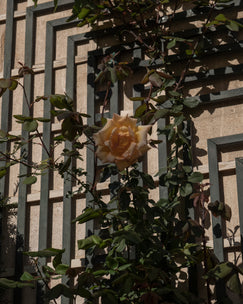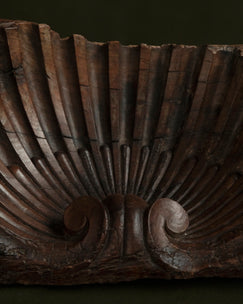Fragrance is a journey. The olfactive experience continues to confound even the most curious and creative. It was there from the beginning and will continue to evolve as we do. From birth and far out into the future, our sense of smell will place us on a map. Like a thumbprint, it formulates our relation to the human experience, imprinting us with a sense of individuality. Two people might agree that a rose smells like a rose – but what does that mean to each person?
The olfactory sense is unique in that no two people can experience it the same way. Perfume is the allure of the invisible, only taking form when applied to our histories. It tells us in whispers the stories that we can’t see, it directs us with a sense of familiarity to places we don’t know, and it romanticizes the possibility of the future. It is by extension a reflection of the human experience.
A spray of a perfume bottle has the power to make a lasting impression but understanding how to achieve your desired result can be tricky. Whether it’s wondering how to choose a scent that isn’t too strong or too light, or asking yourself what the difference is between an Eau de Parfum and an Eau de Toilette, understanding the basics will help you harness the joy of wearing your fragrance.
Just like in life, a scent is met with a first impression – the longer we sit with it, the more intricate the narrative at play. It’s easy to fall in love with the idea of something lasting forever, but the olfactive is experienced in the subliminal understanding that all things are fleeting; beauty fades and things change. What once was a fresh and budding flower will become an indolic air of pollen, fresh leather will dry out, and soft grass will toast to hay.
It’s human to want our favorite moments to perdure until we are satisfied – a good perfume included. The cycle of a fragrance is a story to be revealed over time. Understanding just how long it will last and how it will project shouldn’t remain a mystery.
WHAT IS PERFUME?
A partial answer to our question can be found right under our noses. Customarily we will see the concentration, or “strength” of a fragrance listed on the packaging and bottle – and almost always in French. This includes the “Eau de Parfum” you will see listed on any bottle from Maison d’Etto. There are many other concentrations whose names do not translate literally but each indicates the longevity, projection, and style of a fragrance. The major categories include:
Eau de Cologne (EDC) 2-4%
Eau de Toilette (EDT) 3-15%
Eau de Parfum (EDP) 15-20%
Extrait de Parfum 20-40%
Pure Parfum 100%

There are several classifications of perfume concentrations starting with the strongest being Pure Parfum, followed by an Extrait de Parfum which is a dilution of 15-40% of the fragrance in alcohol; an Eau de Parfum has around 15-20%; an Eau de Toilette 3-15%, and Eau de Cologne 2-4%. Each is formulated with a purpose in mind, and each concentration allows for the aromatic compounds to shine through differently on the skin.
A fragrance is a blend of pure oils (distillates, essential oils, concretes, absolutes, and aroma chemicals) with a carrier: usually a dilution of alcohol and water, sometimes oil. So you might be asking yourself isn’t more perfume oil more of a good thing? Not necessarily. We’ll break it down.
UNDERSTANDING CONCENTRATIONS
Pure Parfum is uncommon as it has yet to be worked into a fully composed fragrance. It is often very expensive and unpalatable and more so adept for the use of a perfumer. Take for example Jasmine oil, which in higher concentrations can smell chalky, animalic, perhaps even fruity, unlike the delicate floral that we’re used to. Some ingredients in higher doses can counter the idea of what the nose desires or might expect.
To create the illusion of levity and nuance the perfumer must play to the strengths of each ingredient. In this way, the best perfumes exhibit a balance of power and restraint. A great perfume should allow for each aroma to come to the stage of the wearer’s skin, this way the scent becomes a performance, a story, a journey, complete with dips and turns and subtle surprises. If each note performed at its fullest potential we might never come to understand the spectrum of their attraction.
Extrait de Parfums tend to smell the most intense and diffusive. This concentration can be alluring for those who want the utmost performance out of their fragrance. They are constructed with longevity and projection in mind, but to do this they largely sacrifice showcasing delicate notes in favor of the heaviest.
Following is our favorite category of Eau de Parfums, which capitalizes on the fullest expression of notes from the most delicate to the most profound. Their evolution is almost orchestral and has become the main method of story-telling with Maison d’Etto precisely because of their ability to express quality with subtlety. Invented in the 1980s as the new formula of modernity the EDP is both adept to vintage and contemporary styles.
An Eau de Toilette is not far off and historically has been the hook that captivates the passerby’s first whiff, perhaps because it is concerned mostly with the airy, crisp, and effervescent notes. They are less likely to focus on depth. Notes such as smoke, earth, and leather would fall apart in an EDT and are less the point of this style. This in turn makes them more affordable as they don’t have to focus on the expense of rare materials.
Lastly is the Eau de Cologne which has mostly fallen out of fashion, in part due to its delicate nature. It can be traced back to the 1700s with an original formulation of neroli, bergamot, and orange blossom. The style was once marketed as an uplifting elixir, but as the essence of simplicity, it is gone nearly as quickly as it was applied.
MAKING IT YOUR OWN
You may come across stray labels of other concentrations which may have become victims to more popular styles or were just commercial efforts for brands to distinguish themselves as new and exciting. The most confusing of the genres to be demystified is the application of “perfume” as the feminine and “cologne” as the masculine. These are simply American misnomers and bear no weight on the type of fragrance you enjoy.
Understanding that different concentrations work to highlight certain styles and olfactive notes you can now begin to experiment with confidence when spraying on skin. Bear in mind that there are exceptions to how fragrance performs; part of that is the nature of the ingredients and the intention of the perfumer. For us, we have found a voice in the Eau de Parfum. From the first spray to the last sniff, paper to skin, our inspiration to yours…the journey is one that can’t be recreated.









